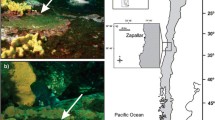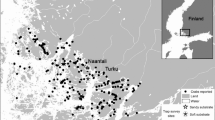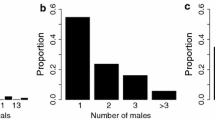Abstract
Microspathodon dorsalis is a conspicuous territorial species found in rocky reef systems along the Eastern Pacific whose mating system is not fully understood regarding aspects such as nest distribution, egg predation patterns, and overall reproductive-related behavior. Spatially explicit models indicate that individuals and their nests correlated with substrate structure, principally rocks followed by live Pocillopora spp. corals. Nest size was not related to fish size in the center and along the periphery of the nesting colonies, suggesting that female did not choose males based on size. Up to 11,792 interactions (536 ± 2256.97 interactions/nest) at a rate of 5.95 (± 0.47) interactions/minute were recorded, most of which resulted in unsuccessful predation attempts (63%), while the remaining percent (37%) resulted in successful predation attempts. Thalassoma lucasanum fed heavily on M. dorsalis eggs, followed by Stegastes acapulcoensis and Johnrandallia nigrirostris. The frequency, interaction type, and interacting species varied across space and time, probably due to the spatial location of the nests and the distribution patterns of the interacting species, as well as a consequence of the seasonal environmental variation of the area.


Similar content being viewed by others
Data availability
The datasets generated during and/or analyzed during the current study are available from the corresponding author on reasonable request.
Code availability
Not applicable.
References
Aburto-Oropeza O, Balart EF (2001) Community structure of reef fish in several habitats of a rocky reef in the Gulf of California. Mar Ecol 22:283–305. https://doi.org/10.1046/j.1439-0485.2001.01747.x
Aguilar-Medrano R, Frederich B, Balart EF, de Luna E (2013) Diversification of the pectoral fin shape in damselfishes (Perciformes, Pomacentridae) of the Eastern Pacific. Zoomorphology 132:197–213. https://doi.org/10.1007/s00435-012-0178-8
Albrecht H (1969) Behaviour of four species of Atlantic damselfishes from Columbia, South America, (Abudefduf saxatilis, A. taurus, Chromis multilineata, C. cyanea; Pisces, Pomacentridae). Z Tier Psychol 26:662–676. https://doi.org/10.1111/j.1439-0310.1969.tb01969.x
Alevizon WS (1976) Mixed schooling and its possible significance in a tropical western Atlantic parrotfish and surgeonfish. Copeia 1976:796–798. https://doi.org/10.2307/1443464
Álvarez-Filip L, Reyes-Bonilla H, Calderón-Aguilera LE (2006) Community structure of fishes in Cabo Pulmo reef, Gulf of California. Mar Ecol 27:253–262. https://doi.org/10.1111/j.1439-0485.2006.00108.x
Anderson MJ (2001) A new method for non-parametric multivariate analysis of variance. Austral Ecol 26:32–46. https://doi.org/10.1111/j.1442-9993.2001.01070.pp.x
Anderson K, Gaston KJ (2013) Lightweight unmanned aerial vehicles will revolutionize spatial ecology. Front Ecol Environ 11:138–146. https://doi.org/10.1890/120150
Anselin L (1995) Local indicators of spatial association-LISA. Geogr Anal 27:93115. https://doi.org/10.1111/j.1538-4632.1995.tb00338.x
Barber I, Nairn D, Huntingford FA (2001) Nests as ornaments: revealing construction by male sticklebacks. Behav Ecol 12:390–396. https://doi.org/10.1093/beheco/12.4.390
Barber I (2013) The evolutionary ecology of nest construction: insight from recent fish studies. Avian Biol Res 6:83–98. https://doi.org/10.3184/175815513X13609538379947
Barneche DR, Floeter SR, Ceccarelli DM, Frensel DMB, Dinslaken DF, Mário HFS, Ferreira CEL (2009) Feeding macroecology of territorial damselfishes (Perciformes: Pomacentridae). Mar Biol 156:289–299. https://doi.org/10.1007/s00227-008-1083-z
Benson AA, Muscatine L (1974) Wax in coral mucus: energy transfer from corals to reef fishes 1. Limnol Oceanogr 19:810–814. https://doi.org/10.4319/lo.1974.19.5.0810
Berglund A (1997) Mating systems and sex allocaction. In: Godin J (ed) Behavioural Ecology of Teleost Fishes. Oxford University Press, Oxford, pp 237–265
Bessa E, Sabino J (2012) Territorial hypothesis predicts the trade-off between reproductive opportunities and parental care in three species of damselfishes (Pomacentridae: Actinopterygii). Lat Am J Aquat Res 40:134–141. https://doi.org/10.3856/vol40-issue1-Fulltext-13
Bocanegra-Castillo N (1995) Aspectos biologicos del pez Microspathodon dorsalis (Gill, 1863) en la zona rocosa de Bahía de Navidad, Jalisco durante el periodo verano-otoño 1983. Dissertation, Universidad de Guadalajara. CUCBA División de Cs. Biológicas y Ambientales. Repositorio Dspace. http://repositorio.cucba.udg.mx:8080/xmlui/handle/123456789/2767
Cech L (2016) Nesting Behavior of Acapulco damselfish (Stegastes acapulcoensis): pairs defend nests more vigorously than solitary males. Tropical Ecology and Conservation [Monteverde Institute]. Dissertation, University of South Florida. Digital Commons. https://digitalcommons.usf.edu/tropical_ecology/428
Celemín JP (2009) Autocorrelación espacial e indicadores locales de asociación espacial. Importancia, estructura y aplicación. Revi Univ Geog 18:11–31
Chapa-Balcorta C, Hernandez-Ayon JM, Durazo R, Beier E, Alin SR, López-Pérez A (2015) Influence of post-Tehuano oceanographic processes in the dynamics of the CO2 system in the Gulf of Tehuantepec, Mexico. J Geophys Res Oceans 120:7752–7770. https://doi.org/10.1002/2015JC011249
Coles SL, Strathmann R (1973) Observations on coral mucus “flocs” and their potential trophic significance. Limnol Oceanogr 18:673–678. https://doi.org/10.4319/lo.1973.18.4.0673
Danilowicz BS (1995) The role of temperature in spawning of the damselfish Dascyllus albisella. Bull Mar Sci 3:624–636
Deal ND, Lehtonen TK, Lindström K, Wong BB (2017) Paternal investment with an uncertain future: effects of predator exposure on filial cannibalism and nesting behaviour. Anim Behav 132:81–90. https://doi.org/10.1016/j.anbehav.2017.07.024
Dominici-Arosemena A, Wolff M (2006) Reef fish community structure in the tropical eastern Pacific (Panamá): living on a relatively stable rocky reef environment. Helgol Mar Res 60:287. https://doi.org/10.1007/s10152-006-0045-4
Downhower JF, Brown L (1980) Mate preferences of female mottled sculpins, Cottus bairdi. Anim Behav 28:728–734. https://doi.org/10.1016/S0003-3472(80)80132-1
Ebersole JP (1977) The adaptive significance of interspecific territoriality in the reef fish Eupomacentrus leucostictus. Ecol 58:914–920. https://doi.org/10.2307/1936228
Ehrlich PR (1975) The population biology of coral reef fishes. Ann Rev Ecol Syst 6:211–247. https://doi.org/10.1146/annurev.es.06.110175.001235
Emlen ST, Oring LW (1977) Ecology, sexual selection and the evolution of mating systems. Sci 197:215–223
Enochs IC, Glynn PW (2017) Corallivory in the Eastern Pacific. In: Glynn PW, Manzello DP, Enochs IC (eds) Coral reefs of the eastern tropical Pacific: persistence and loss in a dynamic environment, vol 8. Springer, pp 315–337
Espinoza M, Salas E (2005) Estructura de las comunidades de peces de arrecife en las Islas Catalinas y Playa Ocotal, Pacífico Norte de Costa Rica. Rev Biol Trop 53:523–536. https://doi.org/10.15517/rbt.v53i3-4.14667
Fishelson L (1998) Behaviour, socio-ecology and sexuality in damselfishes (Pomacentridae). Ital J Zool 65:387–398. https://doi.org/10.1080/11250009809386853
Foster SA (1989) The implications of divergence in spatial nesting patterns in the geminate Caribbean and Pacific sergeant major damselfishes. Anim Behav 37:465–476. https://doi.org/10.1016/0003-3472(89)90093-6
Frédérich B, Sorenson L, Santini F, Slater GJ, Alfaro ME (2013) Iterative ecological radiation and convergence during the evolutionary history of damselfishes (Pomacentridae). Amer Nat 181:94–113. https://doi.org/10.1086/668599
Frédérich B, Parmentier E (2016) Biology of damselfishes. CRC Press
Gibson RN, Barnes M, Atkinson RJ (2001) Territorial damselfishes as determinants of the structure of benthic communities on coral reefs. Oceanogr Mar Biol 39:355–389
Goulet D (1997) Reproductive behavior and spawning success of female Amblyglyphidodon leucogaster (Pisces: Pomacentridae) from the Red Sea. Environ Biol Fish 50:49–60. https://doi.org/10.1023/A:1007350601234
Griffith SC, Owens IP, Thuman KA (2002) Extra pair paternity in birds: a review of interspecific variation and adaptive function. Mol Ecol 11:2195–2212. https://doi.org/10.1046/j.1365-294X.2002.01613.x
Gross MR, MacMillan AM (1981) Predation and the evolution of colonial nesting in bluegill sunfish (Lepomis macrochirus). Behav Ecol Sociobiol 8:163–174. https://doi.org/10.1007/BF00299826
Hamilton WD (1971) Geometry for the selfish herd. J Theor Biol 31:295–311. https://doi.org/10.1016/0022-5193(71)90189-5
Hoelzer GA (1990) Male-male competition and female choice in the Cortez damselfish, Stegastes rectifraenum. Anim Behav 40:339–349. https://doi.org/10.1016/S0003-3472(05)80929-7
Hoelzer GA (1995) Filial cannibalism and male parental care in damselfishes. Bull Mar Sci 57:663–671
Howard RD (1978) The evolution of mating strategies in bullfrogs, Rana catesbeiana. Evol 32:850–871. https://doi.org/10.1111/j.1558-5646.1978.tb04639.x
Jennings MJ, Philipp DP (1992) Female choice and male competition in longear sunfish. Behav Ecol 3:84–94. https://doi.org/10.1093/beheco/3.1.84
Johannes RE (1967) Ecology of organic aggregates in the vicinity of a coral reef. Limnol Oceanogr 12:189–195. https://doi.org/10.4319/lo.1967.12.2.0189
Juárez-Hernández LG, Tapia-García M, Luna-Monsivais B (2013) Estructura de las comunidades de peces de las bahías Maguey y Cacaluta, Huatulco, Oaxaca. Rev Mex Biodivers 84:1243–1257. https://doi.org/10.7550/rmb.28910
Juárez-Hernández LG, Tapia-García M (2017) Variación espacial en número de especies, abundancia y diversidad de peces en las Bahías de Huatulco, Oaxaca, México. Rev Biol Trop 65:1407–1418. https://doi.org/10.7550/rmb.28910
Juárez-Hernández LG, Tapia-García M (2018) Listado ictiofaunístico de las bahías del Parque Nacional Huatulco, Oaxaca, México. Arxius de Miscel· lània Zoològica 16:96–111. https://doi.org/10.32800/amz.2018.16.0096
Kalacska M, Lucanus O, Sousa L, Vieira T, Arroyo-Mora JP (2018) Freshwater fish habitat complexity mapping using above and underwater structure-from-motion photogrammetry. Remote Sens 10:1912. https://doi.org/10.3390/rs10121912
Karino K, Nakazono A (1993) Reproductive behavior of the territorial herbivore Stegastes nigricans (Pisces: Pomacentridae) in relation to colony formation. J Ethol 11:99–110. https://doi.org/10.1007/BF02350043
Klug H (2011) Animal mating systems. eLS. John Wiley & Sons. Ltd: Chichester. https://doi.org/10.1002/9780470015902.a0022553
Klug H, Lindströum K, Mary CMS (2006) Parents benefit from eating offspring: density-dependent egg survivorship compensates for filial cannibalism. Evol 60:2087–2095. https://doi.org/10.1111/j.0014-3820.2006.tb01846.x
Legendre P, Fortin MJ (1989) Spatial pattern and ecological analysis. Vegetatio 80:107–138. https://doi.org/10.1007/BF00048036
Lequeux BD, Ahumada-Sempoal MA, López-Pérez A, Reyes-Hernandez C (2018) Coral connectivity between equatorial Eastern Pacific marine protected areas: a biophysical modeling approach. PloS One 13:e0202995. https://doi.org/10.1371/journal.pone.0202995
Lobel PS (1978) Diel, lunar, and seasonal periodicity in the reproductive behavior of the pomacanthid fish, Centropyge potteri, and some other reef fishes in Hawaii. Pac Sci 32:193–207
López-Pérez RA, Calderon-Aguilera LE, Zepeta-Vilchis RC, López Pérez Maldonado I, López Ortiz AM (2013) Species composition, habitat configuration and seasonal changes of coral reef fish assemblages in western Mexico. J Appl Ichthyol 29:437–448. https://doi.org/10.1111/jai.12029
Low RM (1971) Interspecific territoriality in a pomacentrid reef fish, Pomacentrus flavicauda Whitley. Ecol 52:648–654. https://doi.org/10.2307/1934153
Manica A (2002) Filial cannibalism in teleost fish. Biol Rev 77:261–277. https://doi.org/10.1017/S1464793101005905
Manica A (2004) Parental fish change their cannibalistic behaviour in response to the cost-to-benefit ratio of parental care. Anim Behav 67:1015–1021. https://doi.org/10.1016/j.anbehav.2003.09.011
Manica A (2010) Female scissortail sergeants (Pisces: Pomacentridae) use test eggs to choose good fathers. Anim Behav 79:237–242. https://doi.org/10.1016/j.anbehav.2009.11.006
Montgomery WL (1975) Interspecific associations of sea-basses (Serranidae) in the Gulf of California. Copeia 1975:785–787. https://doi.org/10.2307/1443342
Montgomery WL (1980) Comparative feeding ecology of two herbivorous damselfishes (Pomacentridae: Teleostei) from the Gulf of California, Mexico. J Exp Mar Biol Ecol 47:9–24. https://doi.org/10.1016/0022-0981(80)90134-3
Montgomery WL (1981) Mixed-species schools and the significance of vertical territories of damselfishes. Copeia 1981:477–481. https://doi.org/10.2307/1444245
Moran PA (1950) Notes on continuous stochastic phenomena. Biometrika 37:17–23. https://doi.org/10.2307/2332142
Myrberg AA Jr, Thresher RE (1974) Interspecific aggression and its relevance to the concept of territoriality in reef fishes. Am Zool 14:81–96. https://doi.org/10.1093/icb/14.1.81
Neff BD, Cargnelli LM, Côté IM (2004) Solitary nesting as an alternative breeding tactic in colonial nesting bluegill sunfish (Lepomis macrochirus). Behav Ecol Sociobiol 56:381–387. https://doi.org/10.1007/s00265-004-0792-7
Norman MD, Jones GP (1984) Determinants of territory size in the pomacentrid reef fish, Parma victoriae. Oecologia 61:60–69. https://doi.org/10.1007/bf00379090
Ord JK, Getis A (1995) Local spatial autocorrelation statistics: distributional issues and an application. Geogr Anal 27:286–306. https://doi.org/10.1111/j.1538-4632.1995.tb00912.x
Pérez-España H, Galvan-Magaña F, Abitia-Cárdenas LA (1996) Variaciones temporales y espaciales en la estructura de la comunidad de peces de arrecifes rocosos del suroeste del Golfo de California, México. Cienc Mar 22:273–294
Perrone M (1978) Mate size and breeding success in a monogamous cichlid fish. Environ Biol Fish 3:193–201. https://doi.org/10.1007/BF00691943
Platt T, Fuentes-Yaco C, Frank KT (2003) Spring algal bloom and larval fish survival. Nat 423:398–399. https://doi.org/10.1038/423398b
Pressley PH (1980) Lunar periodicity in the spawning of yellowtail damselfish, Microspathodon chrysurus. Environ Biol Fish 5:155–159. https://doi.org/10.1007/BF02391622
Ramírez-Chavez E, Cruz-García A, Lagunas-Pérez AG, Reyes-Carreño O (2013) Uso de vehículos aéreos no tripulados para la caracterización del paisaje sumergido; Bahía Estacahuite. Ciencia y Mar 19:35–40
Rios-Cardenas O, Morris MR (2009) Mating systems and strategies of tropical fishes. In: Del Claro K, Oliveira PS, Rico-Gray V (eds) Tropical Biology and Conservation Management: Zoology, vol VIII. Encyclopedia of life support systems. UNESCO-Eolss Publishers, Oxford, pp 219–240
Robertson DR (1984) Cohabitation of competing territorial damselfishes on a Caribbean coral reef. Ecol 65:1121–1135. https://doi.org/10.2307/1938320
Robertson DR, Allen GR (2015) Shorefishes of the Tropical Eastern Pacific: online information system. Version 2.0 Smithsonian Tropical Research Institute, Balboa, Panamá. https://biogeodb.stri.si.edu/sftep/es/pages
Robertson DR, Sweatman HPA, Fletcher EA, Cleland MG (1976) Schooling as a mechanism for circumventing the territoriality of competitors. Ecol 57:1208–1220. https://doi.org/10.2307/1935045
Robertson DR, Petersen CW, Brawn JD (1990) Lunar reproductive cycles of benthic-brooding reef fishes: reflections of larval biology or adult biology? Ecol Monogr 60:311–329. https://doi.org/10.2307/1943060
Rohwer S (1978) Parent cannibalism of offspring and egg raiding as a courtship strategy. Am Nat 112:429–440. https://doi.org/10.1086/283284
Rotjan RD, Lewis SM (2008) Impact of coral predators on tropical reefs. Mar Ecol Prog Ser 367:73–91. https://doi.org/10.3354/meps07531
Sargent RC (1992) Ecology of filial cannibalism in fish: theoretical perspectives. In: Elgar MA, Crespi BE (eds) Cannibalism: ecology and evolution among diverse taxa. Oxford University Press, Oxford, pp 38–62
Schneider CA, Rasband WS, Eliceiri KW (2012) NIH image to ImageJ: 25 years of image analysis. Nat Methods 9:671–675. https://doi.org/10.1038/nmeth.2089
Smith C, Wootton RJ (1995) The costs of parental care in teleost fishes. Rev Fish Biol Fish 5:7–22. https://doi.org/10.1007/BF01103363
Sponaugle S, Grorud-Colvert K, Pinkard D (2006) Temperature-mediated variation in early life history traits and recruitment success of the coral reef fish Thalassoma bifasciatum in the Florida keys. Mar Ecol Prog Ser 308:1–15. https://doi.org/10.3354/meps308001
Thresher RE (1976) Field analysis of the territoriality of the threespot damselfish, Eupomacentrus planifrons (Pomacentridae). Copeia 1976:266–276. https://doi.org/10.2307/1443946
Urbiola-Rangel E, Chassin-Noria O (2019) Mating and reproductive success associated with male body size in Stegastes acapulcoensis (Teleostei: Pomacentridae). Environ Biol Fish 102:1473–1483. https://doi.org/10.1007/s10641-019-00925-z
Vázquez RI, Rodríguez J, Abitia LA, Galván F (2008) Food habits of the yellow snapper Lutjanus argentiventris (Peters, 1869) (Percoidei: Lutjanidae) in La Paz Bay, Mexico. Rev Biol Mar Oceanog 43:295–302. https://doi.org/10.4067/S0718-19572008000200008
Villarreal-Cavazos A, Reyes-Bonilla H, Bermúdez-Almada B, Arizpe-Covarrubias O (2000) Los peces del arrecife de Cabo Pulmo, Golfo de California, México: Lista sistemática y aspectos de abundancia y biogeografía. Rev Biol Trop 48:413–424
Warner RR, Hughes TP (1989) The population dynamics of reef fishes. Proc 6th Int Coral Reef Symp. James Cook University, Townsville, Australia. 1:149–155. http://www.reefbase.org/
Wellington GM (1982) Depth zonation of corals in the Gulf of Panama: control and facilitation by resident reef fishes. Ecol Monogr 52:223–241. https://doi.org/10.2307/2937329
Westoby MJ, Brasington J, Glasser ND, Hambrey MJ, Reynolds JM (2012) Structure-from-Motion’photogrammetry: a low-cost, effective tool for geoscience applications. Geomorph 179:300–314. https://doi.org/10.1016/j.geomorph.2012.08.021
Williams AH (1978) Ecology of threespot damselfish: social organization, age structure, and population stability. J Exp Mar Biol Ecol 34:197–213. https://doi.org/10.1016/S0022-0981(78)80002-1
Young GC, Dey S, Rogers AD, Exton D (2017) Cost and time-effective method for multi-scale measures of rugosity, fractal dimension, and vector dispersion from coral reef 3D models. PLoS One 12:e0175341. https://doi.org/10.1371/journal.pone.0175341
Zar J (2010) Biostatistical analysis, 5th edn. Prentice Hall, Englewood Cliffs
Acknowledgements
We thank Virgilio Antonio Pérez and Carlos López Armeria from Buceo Huatulco Center and Lydia Ladah for proofreading the manuscript. In addition, two anonymous reviewers’ comments and suggestions vastly improved the manuscript.
Funding
Funding and support for these works have been provided by Universidad del Mar (grant UMAR CUP 2II1901 to PTH), Universidad Autónoma Metropolitana, and Consejo Nacional de Ciencia y Tecnología (CONACYT) (grant 236654 to ALP). TGM (#275299) and OVM (#275299) received a fellowship from CONACYT.
Author information
Authors and Affiliations
Corresponding author
Ethics declarations
Ethics approval
This article does not contain any studies with animals performed by any of the authors.
Consent to participate
Not applicable.
Consent for publication
The authors consent to publication of the manuscript, which has not been previously published in any journal.
Competing interests
The authors declare no competing interests.
Additional information
Publisher's note
Springer Nature remains neutral with regard to jurisdictional claims in published maps and institutional affiliations.
Supplementary Information
Below is the link to the electronic supplementary material.
Supplementary file1 (MP4 1799 KB)
Supplementary file2 (MP4 1197 KB)
Supplementary file3 (MP4 1669 KB)
Supplementary file4 (MP4 1945 KB)
Supplementary file5 (MP4 2013 KB)
Rights and permissions
Springer Nature or its licensor (e.g. a society or other partner) holds exclusive rights to this article under a publishing agreement with the author(s) or other rightsholder(s); author self-archiving of the accepted manuscript version of this article is solely governed by the terms of such publishing agreement and applicable law.
About this article
Cite this article
González-Mendoza, T., López-Pérez, A., Valencia-Méndez, O. et al. Nesting sites and parental care in the giant blue damselfish, Microspathodon dorsalis. Environ Biol Fish 106, 79–91 (2023). https://doi.org/10.1007/s10641-022-01378-7
Received:
Accepted:
Published:
Issue Date:
DOI: https://doi.org/10.1007/s10641-022-01378-7




